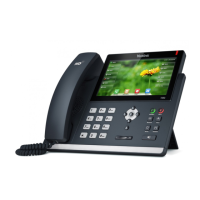Administrator’s Guide for SIP-T2 Series/T19(P) E2/T4 Series/CP860 IP Phones
62
IP phones perform the auto provisioning function of downloading configuration files,
downloading resource files and upgrading firmware. The transfer protocol is used to
download files from the provisioning server. IP phones support several transport
protocols for provisioning, including FTP, TFTP, HTTP, and HTTPS protocols. And you can
specify the transport protocol in the provisioning server address, for example,
http://xxxxxxx. If not specified, the TFTP protocol is used. The provisioning server
address can be IP address, domain name or URL. If a user name and password are
specified as part of the provisioning server address, for example,
http://user:pwd@/server/dir, they will be used only if the server supports them.
Note
The provisioning server can be on the local LAN or anywhere on the Internet. Use the
following procedure as a recommendation if this is your first provisioning server setup.
For more information on how to set up a provisioning server, refer to
Yealink_SIP-T2_Series_T19(P) E2_T4_Series_CP860_IP_Phones_Auto_Provisioning_Guide
.
To set up the provisioning server:
1. Install a provisioning server application or locate a suitable existing server.
2. Create an account and home directory.
3. Set security permissions for the account.
4. Create configuration files and edit them as desired.
5. Copy the configuration files and resource files to the provisioning server.
For more information on how to deploy IP phones using configuration files, refer to
Deploying Phones from the Provisioning Server on page 63.
Note
Typically all phones are configured with the same server account, but the server account
provides a means of conveniently partitioning the configuration. Give each account a
unique home directory on the server and change the configuration on a per-line basis.
A URL should contain forward slashes instead of back slashes and should not contain
spaces. Escape characters are not supported.
If a user name and password are not specified as part of the provisioning server
address, the User Name and Password of the provisioning server configured on the
phone will be used.
There are two types of FTP methods—active and passive. IP phones are not compatible

